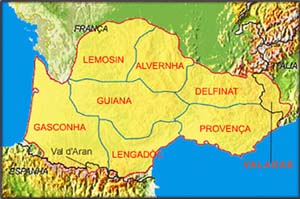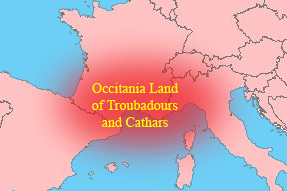The Trobairiz (Women Troubadours ( Trobairiz,
Trobairiz,  Trouvèresses)
Trouvèresses)
  In
line with the greater equality enjoyed by women in Occitania
- the Medieval Languedoc - compared to their sisters elsewhere
in Christendom, a number of female troubadours are known.
A woman troubadour
is called a Trobairitz. The word trobairitz was first
used in a 13th-century romance Flamenca. It comes
from the Occitan word trobar, the same word that gives us
troubadour, the technical meaning of which is "to compose".
The word Trobairitz is the same in the singular and the
plural. In
line with the greater equality enjoyed by women in Occitania
- the Medieval Languedoc - compared to their sisters elsewhere
in Christendom, a number of female troubadours are known.
A woman troubadour
is called a Trobairitz. The word trobairitz was first
used in a 13th-century romance Flamenca. It comes
from the Occitan word trobar, the same word that gives us
troubadour, the technical meaning of which is "to compose".
The word Trobairitz is the same in the singular and the
plural.
Both troubadours and trobairitz wrote of fin' amors,
or courtly love. Trobairitz typically composed cansos (strophic
songs) and tensos (debate poems). Trobairitz are notable
in western musical history as the first known female composers
of secular music (There had been earlier women composers,
but they are known only for sacred music). Although the
troubadour tradition welcomed both women and the lower classes,
we know of no lower class trobairitz - all known trobairitz
were nobly born (lower class women could become joglaresses,
and we know of no noble joglaresses).
  The
names of about twenty trobairitz from the 12th and 13th
centuries survive, to whom between 23 and 46 works are attributed.
There are number of reasons why it is not always easy to
distinguish a troubadour from a trabairitz: The
names of about twenty trobairitz from the 12th and 13th
centuries survive, to whom between 23 and 46 works are attributed.
There are number of reasons why it is not always easy to
distinguish a troubadour from a trabairitz:
- Gender may not be apparent from a poet's name - especially
when we know only a pen name or the author is anonymous.
-
The first chansonniers did not separate
the works of troubadours from those of trobairitz. Only
in later Italian and Catalan chansonniers were trobairitz
placed in a separate section of the books.
-
In the courtly love tradition it was
common for poems to be written as an exchange of letters,
or a debate, as in a tenso. Some of these were originally
a real exchange of letters between a man and a woman,
later gathered together in a manuscript. Modern editors
have been known to attribute these solely to the man who
originated the exchange.
-
Since poetry was stylised, it is difficult
to know when a poet speaking as a woman actually was a
woman, or a man speaking as a woman. Similarly for women
writing as men.
  The
question has arisen as to why it should have been the medieval
Languedoc that saw such the first flourishing of so many
ideas: sexual equality, the decoupling of sex and sin, literary
creativity, and so on. Why the trobairitz first appeared
in the Languedoc can be explained by a conjugation of factors.
First, Occitan society was already far more accepting of
women than other European societies of the time; it was
ahead of the rest of Europe in many ways. Second, since
the end of the eleventh century many nobles of the Languedoc
had followed their suzerains, the Counts of Toulouse, on
crusade to the Holy Land - leaving their ladies in charge:
Women in the Languedoc were accustomed to administering
estates, dispensing justice and even defending castles.
Writing songs could hardly have been a great leap for such
women. Third, The Languedoc at this time neighboured Moslem
Spain. Spanish Moslems knew how to have fun and the idea
of women poets may well have filtered into Christian Europe
through the Languedoc from the culturally more sophisticated
Moslem Europe. Indeed, Occitania itself had been Moslem
earlier in the Middle Ages. The
question has arisen as to why it should have been the medieval
Languedoc that saw such the first flourishing of so many
ideas: sexual equality, the decoupling of sex and sin, literary
creativity, and so on. Why the trobairitz first appeared
in the Languedoc can be explained by a conjugation of factors.
First, Occitan society was already far more accepting of
women than other European societies of the time; it was
ahead of the rest of Europe in many ways. Second, since
the end of the eleventh century many nobles of the Languedoc
had followed their suzerains, the Counts of Toulouse, on
crusade to the Holy Land - leaving their ladies in charge:
Women in the Languedoc were accustomed to administering
estates, dispensing justice and even defending castles.
Writing songs could hardly have been a great leap for such
women. Third, The Languedoc at this time neighboured Moslem
Spain. Spanish Moslems knew how to have fun and the idea
of women poets may well have filtered into Christian Europe
through the Languedoc from the culturally more sophisticated
Moslem Europe. Indeed, Occitania itself had been Moslem
earlier in the Middle Ages.
  Few
contemporary sources of information on individual trobairitz
survive. Almost all information about them comes from their
biographies (vidas) and from contextual explanations of
their songs (razós) that were assembled in song collections
(chansonniers). Vidas are unreliable since they are often
no more than romanticised extrapolations from the poems
themselves. Here are the names of some trobairitz: Few
contemporary sources of information on individual trobairitz
survive. Almost all information about them comes from their
biographies (vidas) and from contextual explanations of
their songs (razós) that were assembled in song collections
(chansonniers). Vidas are unreliable since they are often
no more than romanticised extrapolations from the poems
themselves. Here are the names of some trobairitz:
-
 La Comtessa
da Día La Comtessa
da Día (Beatriz de Día, Beatrice, Countess
of Die, known in 1200): Trobairitz from on the Drôme
in the Marquisate of Provence, part of the territories
of the Counts of Toulouse. She was the daughter of Count
Isoard II of Día. According to her vida, she was
in love with Raimbaut of Orange, but married to Guilhem
de Poitiers, Count of Viennois. Her surviving works include
"A chantar m'er de so q'ieu non volria","Ab
joi et ab joven m'apais", "Estat ai en greu
cossirier" Her canso "A chantar m'er de so qu'eu
no volria" is the only work by a trobairitz to survive
with its music. Works include: 4 cansos and 1 tenson.
Click on the following link for one
of her works (with an English translation) 
-
Azalais de Porcairagues (known
in 1173). Trobairitz from the area of Languedoc - thought
to be from the village now known as Portiragnes, east
of Béziers). She was said to have been in love
with Gui Guerrejat, the brother of William VII of Montpellier,
Her surviving work is a canso of 52 lines but no music.
-
Na Castelhoza (Castelloza, known
in 1210) : Trobairitz from the area of Auvergne. Her husband
was Turc de Mairona. The subject of her poems is courtly
love. Three of her poems are extant, but no music survives.
Works include: 3 cansos "Ja de chantar non degra
aver talan", "Amics, s'ie-us trobes avinen"
and "Mout avetz faich lonc estatge"
-
Lombarda (dates unknown) : Trobairitz
from the area of Languedoc, and County of Foix. Works
include: 1 cobla
-
Maria de Ventadorn (known in
1180-1215) : Trobairitz from the area of Limousin and
Marche. Works include: 1 partimen
-
Garsenda de Forcalquier (Garsenda
de Provença, dates unknown) : Trobairitz from the
area of Provence. Works include: 1 tenso
|
|
 Back
to: Occitan Back
to: Occitan |

|
Next
Page: Occitania 
|
|
|

![]() In
line with the greater equality enjoyed by women in Occitania
- the Medieval Languedoc - compared to their sisters elsewhere
in Christendom, a number of female troubadours are known.
A woman troubadour
is called a Trobairitz. The word trobairitz was first
used in a 13th-century romance Flamenca. It comes
from the Occitan word trobar, the same word that gives us
troubadour, the technical meaning of which is "to compose".
The word Trobairitz is the same in the singular and the
plural.
In
line with the greater equality enjoyed by women in Occitania
- the Medieval Languedoc - compared to their sisters elsewhere
in Christendom, a number of female troubadours are known.
A woman troubadour
is called a Trobairitz. The word trobairitz was first
used in a 13th-century romance Flamenca. It comes
from the Occitan word trobar, the same word that gives us
troubadour, the technical meaning of which is "to compose".
The word Trobairitz is the same in the singular and the
plural.
![]() The
names of about twenty trobairitz from the 12th and 13th
centuries survive, to whom between 23 and 46 works are attributed.
There are number of reasons why it is not always easy to
distinguish a troubadour from a trabairitz:
The
names of about twenty trobairitz from the 12th and 13th
centuries survive, to whom between 23 and 46 works are attributed.
There are number of reasons why it is not always easy to
distinguish a troubadour from a trabairitz:
 Trouvèresses)
Trouvèresses) 

 La Comtessa
da Día (Beatriz de Día, Beatrice, Countess
of Die, known in 1200): Trobairitz from on the Drôme
in the Marquisate of Provence, part of the territories
of the Counts of Toulouse. She was the daughter of Count
Isoard II of Día. According to her vida, she was
in love with Raimbaut of Orange, but married to Guilhem
de Poitiers, Count of Viennois. Her surviving works include
"A chantar m'er de so q'ieu non volria","Ab
joi et ab joven m'apais", "Estat ai en greu
cossirier" Her canso "A chantar m'er de so qu'eu
no volria" is the only work by a trobairitz to survive
with its music. Works include: 4 cansos and 1 tenson.
Click on the following link for
La Comtessa
da Día (Beatriz de Día, Beatrice, Countess
of Die, known in 1200): Trobairitz from on the Drôme
in the Marquisate of Provence, part of the territories
of the Counts of Toulouse. She was the daughter of Count
Isoard II of Día. According to her vida, she was
in love with Raimbaut of Orange, but married to Guilhem
de Poitiers, Count of Viennois. Her surviving works include
"A chantar m'er de so q'ieu non volria","Ab
joi et ab joven m'apais", "Estat ai en greu
cossirier" Her canso "A chantar m'er de so qu'eu
no volria" is the only work by a trobairitz to survive
with its music. Works include: 4 cansos and 1 tenson.
Click on the following link for 





